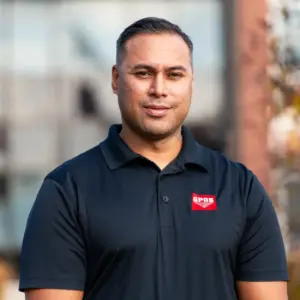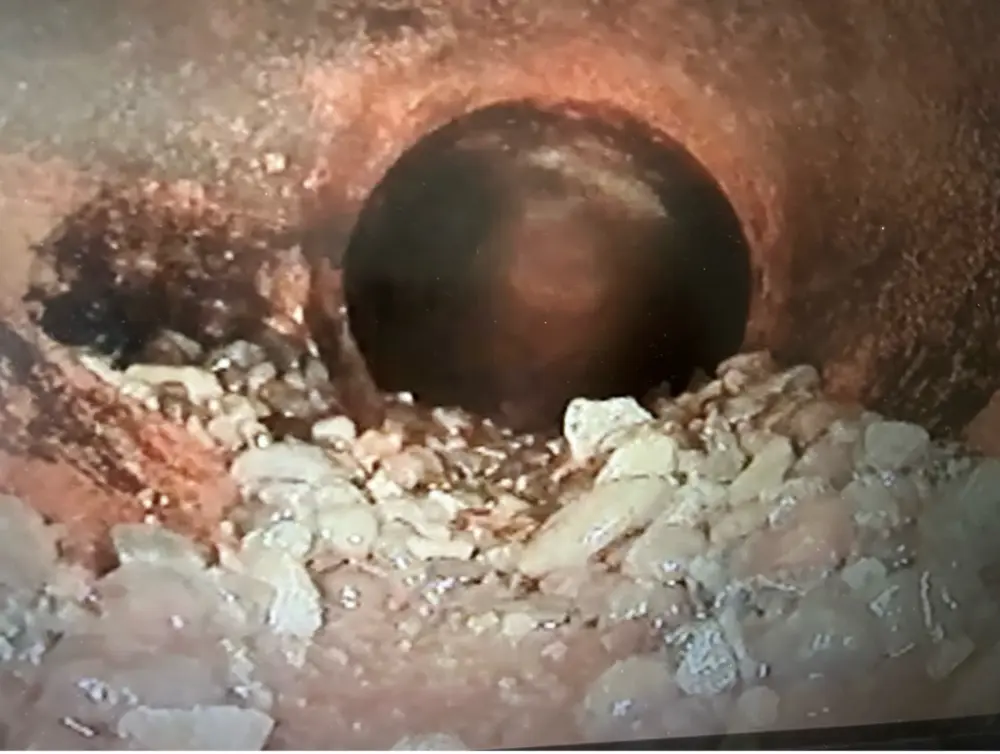When students at Rainier Beach High School in Seattle, Washington, returned from spring break this past school year and entered their brand new, four-story school building, the sanitary sewer lines running underneath the campus would have been the last thing on their minds.
But about a year before the new, 297,000 s.f. school building opened, those pipes were all that contractor Lydig Construction could think about. That’s because they’d discovered that the building’s concrete slab was slowly sinking into the ground, cracking open the new cast iron pipes as it went.
Lydig and the school district needed to pinpoint the location of each break in the pipelines, and they needed an accurate map of the entire buried sewer system, so they could effectively plan a permanent repair. While a plumber working on the project had sewer inspection equipment of their own, however, they had been unable to obtain the data the contractor needed.
So Lydig called GPRS.

Project Manager Robert Rasmussen deployed a combination of a remote-controlled sewer inspection crawler and push-fed sewer scope to provide the contractor with a NASSCO-certified report of their sewer system, complete with photo and video evidence of every defect.
Rasmussen worked together with the contractor, returning to the site several times over the course of a week to inspect and map more segments of the system.
He’d access the system from inside the school by feeding his push-fed scope into the cleanouts. Then, when he couldn’t continue any further due to sediment buildup in the lines, he’d deploy his remote-controlled crawler from a manhole outside and try to meet up with where the scope had run into the blockage. As Rasmussen provided the contractor and plumber with the precise location of each area where water, sediment, and other debris was entering the cracked pipes, a jetting company would use the data to clear the lines so that he could proceed further.
“I was able to pinpoint where all the breaks were in the pipelines, and where all the pea gravel and dirt was coming in from the breakage,” Rasmussen said. “And then I was able to locate all the pipelines.”

In total, Rasmussen inspected 105 linear feet of sewer line. Both his push-fed sewer scope and remote-controlled crawler were equipped with sondes: instrument probes that emit a signal detectable from the surface with an electromagnetic (EM) locator. This allowed Rasmussen to map the sewer system while he was locating defects.
The data Rasmussen collected at Rainier Beach High School helped Lydig and the school district effectively repair the damaged sanitary sewer lines and reroute them to protect from future damage. When students and faculty did finally get to enjoy their new building, they could focus on academics and athletics – and not on what was going on beneath their feet.
“[The client was] very impressed,” he said. “They initially called me out for just one day, to scope some of the lines that their plumbers found and couldn’t really investigate. Then two days after that, they called me back out on site and it ended up being like three or four days of me being out there scoping, to see where the real problem was. Every single one of those new cleanouts and pipelines, they were filled with rock and sediment.”
Whether you need help assessing a brand-new sanitary sewer system, or a decades-old storm line, GPRS’ comprehensive suite of sewer inspection services can help ensure your infrastructure keeps working for you.
We offer video pipe inspection (VPI) using the remote-controlled crawlers and push-fed scopes to create comprehensive NASSCO reports that detail every defect located, ranked by severity and identified with photo and video evidence. You’ll know what needs fixed immediately and exactly where you need to dig to enact those repairs.
NASSCO stands for the National Association of Sewer Service Companies, and they are the industry-leading provider of training and certification programs focused on assessing, maintaining, and rehabilitating underground sanitary sewer and stormwater lines. Every GPRS Project Manager that conducts sewer inspection services has achieved NASSCO certification in pipeline (PACP), manhole (MACP), and lateral (LACP) assessments. So when you hire GPRS, you always know you’re getting the best trained sewer inspection company near you.
Additionally, GPRS can inspect your sewer system using dye tracing or smoke testing, to assess things like flow direction and determine if there are any illegal or incorrect hookups to your lines.
From sewer lines to skyscrapers, GPRS Intelligently Visualizes The Built World® to keep your projects on time, on budget, and safe.
What can we help you visualize?
Frequently Asked Questions
What size sewer pipes can GPRS inspect?
Thanks to our use of both remote-controlled sewer inspection crawlers and push-fed sewer scopes, we’re able to inspect pipes 2” in diameter and up.
Can you locate sewer pipes in addition to evaluating their integrity?
Yes! Our SIM and NASSCO-certified Project Managers use VPI technology equipped with sondes, which are instrument probes that allow them to ascertain the location of underground utilities from an inaccessible location. This allows them to use electromagnetic (EM) locating to map sewer systems at the same time they’re evaluating them for defects.
What deliverables does GPRS offer when conducting a VPI?
GPRS is proud to offer WinCan reporting to our Video Pipe Inspection clients. Maintaining sewers starts with understanding sewer condition, and WinCan allows GPRS Project Managers to collect detailed, NASSCO-compliant inspection data. GPRS Project Managers not only inspect the interior condition of sewer pipes, laterals, and manholes – they can also provide a map of their location. The GPRS Mapping & Modeling Department can provide detailed GPS overlays and CAD files. Our detailed WinCan/NASSCO reports contain screenshots of the interior condition of the pipe segments that we inspect, as well as a video file for further evaluation, documentation, and/or reference.
Does GPRS offer Lateral Launch Services?
Yes, we offer lateral launch capabilities as part of our standard Video Pipe Inspection services.



.svg)